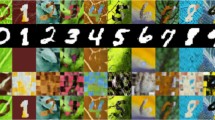Abstract
This paper deals with the classification of multiple pattern observations sets. A set of observations consists of different transformations, possibly including rotation, perspectives and projections. Each set belongs to a single pattern, that is, the pattern is considered invariant under such transformations. The method uses a network representation of the input data to take advantage of the topological relations between the patterns revealed by a low-dimensional manifold. A measurement called modularity is computed to numerically indicate the topological characteristics of the constructed networks. Simulations were carried out in real image data sets, and results have showed that the proposed method outperforms some recent and state-of-the-art techniques.




Similar content being viewed by others
Explore related subjects
Discover the latest articles, news and stories from top researchers in related subjects.References
Bunke H, Riesen K (2011) Recent advances in graph-based pattern recognition with applications in document analysis. Pattern Recogn 44:1057–1067. doi:10.1016/j.patcog.2010.11.015
Chapelle O, Schölkopf B, Zien A (eds) (2006) Semi-supervised learning. MIT Press, Cambridge. http://www.kyb.tuebingen.mpg.de/ssl-book
Conaire O, O’Connor NE, Smeaton AF (2007) An improved spatiogram similarity measure for robust object localisation. In: IEEE International Conference on Acoustics, Speech, and Signal Processing, pp 1069–1072
Dara R, Kremer SC, Stacey DA (2002) Clustering unlabeled data with soms improves classification of labeled real-world data. In: Proceedings of the 2002 International Joint Conference on Neural Networks IEEE vol 3, pp 2237–2242
Djouadi A, Snorrason O, Garber FD (1990) The quality of training sample estimates of the bhattacharyya coefficient. IEEE Trans Pattern Anal Mach Intell 12:92–97
Fujino A, Ueda N, Saito K (2005) A hybrid generative/discriminative approach to semi-supervised classifier design. In: National Conference on Artificial Intelligence, pp 764–769
Fukui K, Yamaguchi O (2005) Face recognition using multi-viewpoint patterns for robot vision. In: Dario P, Chatila R (eds) Robotics research. Springer tracts in advanced robotics, vol 15. Springer, Berlin, pp 192–201
Hadid A, Pietikinen M (2004) From still image to video-based face recognition: An experimental analysis. In: IEEE International Conference on Automatic Face and Gesture Recognition, pp 813–818
Kato T, Kashima H, Sugiyama M (2009) Robust label propagation on multiple networks. IEEE Trans Neural Netw 20:35–44. doi:10.1109/TNN.2008.2003354
Kittler J, Hatef M, Duin RPW, Matas J (1998) On combining classifiers. IEEE Trans Pattern Anal Mach Intell 20:226–239. doi:10.1109/34.667881
Kokiopoulou E, Frossard P (2010) Graph-based classification of multiple observation sets. Pattern Recogn 43:3988–3997
Kokiopoulou E, Frossard P (2011) Distributed classification of multiple observation sets by consensus. IEEE Trans Signal Process 59:104–114
Leibe B, Schiele B (2003) Analyzing appearance and contour based methods for object categorization. In: Computer vision and pattern recognition, pp 409–415
Micheli A (2009) Neural network for graphs: a contextual constructive approach. IEEE Trans Neural Netw 20:498–511
Newman MEJ, Girvan M (2004) Finding and evaluating community structure in networks. Phys Rev E 69(2):026113. doi:10.1103/PhysRevE.69.026113
Sakano H, Mukawa N (2000) Kernel mutual subspace method for robust facial image recognition. In: Knowledge-based intelligent information and engineering systems, pp 245–248
Shakhnarovich G, Fisher J, Darrell T (2002) Face recognition from long-term observations. In: Heyden A, Sparr G, Nielsen M, Johansen P (eds) Computer vision—ECCV 2002. Lecture notes in computer science, vol 2352. Springer, Berlin, pp 851–865. http://dx.doi.org/10.1007/3-540-47977-5_56
Vapnik V (1998) Statistical learning theory. Wiley-Interscience, Hoboken
Zhao T, Nevatia R, Wu B (2008) Segmentation and tracking of multiple humans in crowded environments. IEEE Trans Pattern Anal Mach Intell 30:1198–1211
Zhou D, Bousquet O, Lal TN, Weston J, Schölkopf B (2004) Learning with local and global consistency. In: Advances in neural information processing systems, vol 16. MIT Press, pp 321–328
Zhou D, Schölkopf B (2004) Learning from labeled and unlabeled data using random walks. In: Rasmussen C, Bülthoff H, Schölkopf B, Giese M (eds) Pattern recognition. Lecture notes in computer science, vol 3175. Springer, Berlin, pp 237–244
Zhu X (2007) Semi-supervised learning literature survey. Technical Reports 1530, Computer Sciences, University of Wisconsin-Madison
Acknowledgments
The authors would like to acknowledge the São Paulo State Research Foundation (FAPESP) and the Brazilian National Council for Scientific and Technological Development (CNPq) for the financial support given to this research.
Author information
Authors and Affiliations
Corresponding author
Rights and permissions
About this article
Cite this article
Cupertino, T.H., Silva, T.C. & Zhao, L. Classification of multiple observation sets via network modularity. Neural Comput & Applic 23, 1923–1929 (2013). https://doi.org/10.1007/s00521-012-1115-y
Received:
Accepted:
Published:
Issue Date:
DOI: https://doi.org/10.1007/s00521-012-1115-y




